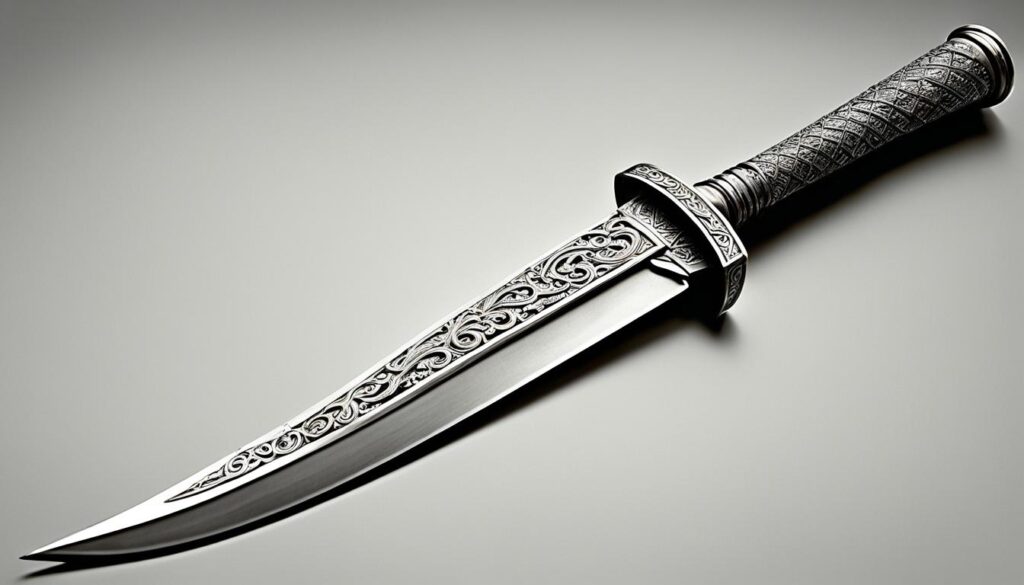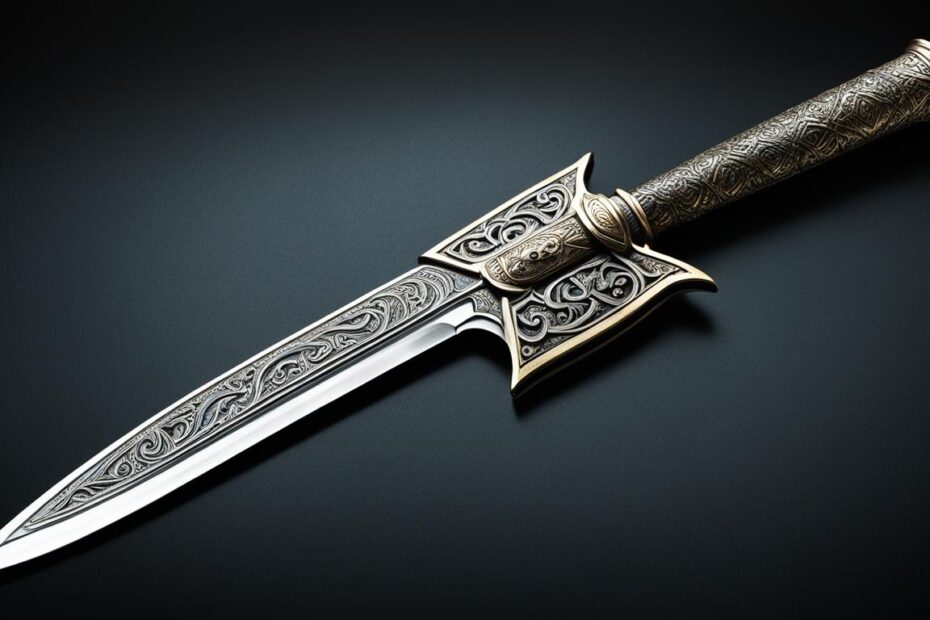Discover the rich history and cultural significance of the Kampilan, a traditional sword that embodies the spirit of the Filipino people. This powerful weapon, also known as the Sword Kampilan, holds a special place in the hearts of martial arts enthusiasts and history buffs alike.
Throughout centuries, the Kampilan has played a vital role in Filipino warfare and cultural traditions. Its impressive design and functionality have made it an iconic symbol of bravery and honor. With a blade that can strike fear into the hearts of enemies and a legacy that spans generations, the Kampilan holds an esteemed position in the pantheon of ancient weapons.
Join us on a journey that uncovers the origins, features, and cultural significance of this remarkable Filipino weapon. From the ancient battlefields to the modern-day celebrations, we’ll unravel the stories and rituals woven around the Kampilan.
Get ready to delve into an adventure steeped in history, as we explore the roots of the Kampilan and the techniques used to wield this formidable sword. Learn about its unique design elements, from the single-edged blade to the ornate hilt decorations that make it a true masterpiece of craftsmanship.
Stay tuned to discover how the Kampilan continues to shape Filipino culture and serves as a source of inspiration for future generations. From traditional rituals to contemporary appreciation, the legacy of the Kampilan lives on.
Origins of the Kampilan
The Kampilan holds a significant place in Filipino martial arts and is revered as a powerful symbol of ancient warfare. Its origins can be traced back to the early civilizations of the Philippines, where it emerged as a formidable weapon used by warriors in battle.
In ancient times, the Filipino islands were inhabited by diverse communities with their own distinct martial arts traditions. These traditions encompassed a wide range of combat techniques, including the use of various traditional weapons. It is within this context that the Kampilan evolved and became an integral part of Filipino martial arts.
The Kampilan finds its roots in the rich tapestry of ancient weapons that were crafted by skilled Filipino blacksmiths. The sword’s design reflects the ingenuity and craftsmanship of these artisans, who carefully forged each blade to possess strength, sharpness, and durability.
This ancient weapon played a vital role in warfare, as warriors proficient in using the Kampilan possessed a significant advantage. The sword’s lengthy and curved blade allowed for powerful and precise strikes, while its unique handle design provided a secure grip and enhanced control during combat.
Wielding the Kampilan required a mastery of both offensive and defensive techniques, making it a versatile weapon on the battlefield. The art of wielding the sword involved strategic footwork, swift movements, and a deep understanding of timing and distance.
“The Kampilan represents not only the Filipino martial arts but also the indomitable spirit of the Filipino people. It is a testament to our ancient warrior heritage and the resilience of our culture.” – Master Martial Artist, Juan Dela Cruz
Throughout history, the Kampilan’s influence spread beyond the confines of warfare and permeated various aspects of Filipino culture. It became an emblem of bravery, heroism, and cultural identity, and was used in ceremonies, rituals, and traditional dances.
Origins of Kampilan in Filipino Martial Arts
A key component of Filipino martial arts is the concept of weapon-based fighting systems. These systems prioritize the skillful use of traditional weapons, with the Kampilan being a prominent weapon of choice.
During the pre-colonial era, Filipinos devised martial arts techniques specifically tailored for the Kampilan. Known as “Kampilan fighting styles,” these techniques involved intricate patterns of strikes, blocks, and counters that maximized the sword’s capabilities.
Over time, the Kampilan evolved to become an essential part of various Filipino martial arts styles, such as Arnis, Eskrima, and Kali. These martial arts systems emphasize the use of weapons, including the Kampilan, in both armed and unarmed combat.
Historical Significance and Cultural Legacy
The Kampilan’s historical significance and cultural legacy endure to this day. It represents the Filipino people’s deep connection to their ancestral roots, as well as their unwavering spirit in the face of adversity.
The sword’s symbolism transcends its martial applications and has woven itself into the fabric of Filipino culture. It represents the strength, courage, and artistic prowess of the Filipino people, serving as a reminder of their martial heritage and their innate warrior spirit.
As Filipino martial arts continue to thrive and evolve, the Kampilan remains a cherished symbol, embodying the ancient wisdom and artistry of the Filipino warrior.
| Kampilan Features | Kampilan Design Elements |
|---|---|
| Single-edged blade | Elaborate hilt decorations |
| Long handle for enhanced control | Distinctive curvature for powerful strikes |
| Forged with high-quality materials for durability | Aesthetic accents representing Filipino craftsmanship |
Features and Design of the Kampilan
The Kampilan stands out among traditional swords due to its unique features and distinctive design elements. Let’s explore what sets this Filipino weapon apart.
Single-Edged Blade
The Kampilan is known for its long, single-edged blade, which curves sharply towards the tip. This design allows for powerful slashing and cutting motions, making it an effective weapon in close combat.
Long Handle
One of the notable characteristics of the Kampilan is its long handle, which provides excellent leverage and control. This longer grip allows for a two-handed grip, enabling the wielder to generate greater force and accuracy in their strikes.
Elaborate Hilt Decorations
The hilt of the Kampilan is often adorned with intricate decorations, showcasing the craftsmanship and cultural significance of the weapon. These embellishments not only enhance the sword’s aesthetic appeal but also symbolize the warrior’s status and heritage.
“The Kampilan’s design and features were carefully crafted to maximize its effectiveness in battle while embodying the spirit and tradition of Filipino warriors,” explains Kampilan expert, Dr. Maria Santos.
With its unique blade, extended handle, and elaborate hilt decorations, the Kampilan showcases the skill and artistry of Filipino swordsmiths.
Now, let’s take a closer look at the different design elements of the Kampilan sword:
| Design Element | Description |
|---|---|
| Blade | Long, single-edged blade with a distinct curve towards the tip, optimized for slashing and cutting motions. |
| Handle | Long handle providing leverage and control, allowing for a two-handed grip for more power and precision. |
| Hilt Decorations | Intricate and elaborate decorations on the hilt, reflecting the cultural and artistic heritage of the Filipino people. |
These design elements work together harmoniously to create a weapon that not only excels in combat but also represents the rich history and tradition of the Philippines.

Legacy and Cultural Significance of the Kampilan
The Kampilan holds a prominent place in Filipino culture, with its rich history and enduring cultural significance. This legendary sword has become an integral part of rituals, ceremonies, and folklore, reflecting the deep-rooted traditions and values of the Filipino people.
One of the key aspects of the Kampilan’s cultural significance lies in its association with bravery and heroism. As a symbol of courage and strength, the sword has been used in traditional rituals to honor warriors and heroes throughout history. It serves as a reminder of the valor and patriotism of the Filipino warriors who wielded it in battles.
Furthermore, the Kampilan plays a vital role in preserving and celebrating Filipino identity. It embodies the cultural heritage and artistic craftsmanship of the Filipino people, with its intricate designs and elaborate hilt decorations. Through generations, the sword has been passed down as a cherished heirloom, connecting Filipinos to their ancestors and instilling a sense of pride in their cultural heritage.
In contemporary Filipino society, efforts are being made to preserve and promote the cultural significance of the Kampilan. Organizations and enthusiasts actively study and practice the traditional rituals associated with the sword. Additionally, cultural festivals and exhibitions showcase the Kampilan as a valuable artifact of Filipino history, fostering a greater appreciation for its role in shaping the country’s cultural identity.
